
Sonora wheat loaf on the left, Joachin Oro loaf on the right.
I’ve gone through a number of bread baking conversion experiences over the last 20 years. I began with Nancy Silverton cookbook, moved on to the cult of Chad Robertson and have finally ended up drinking the whole grain cool aid of pro-bakers Craig Ponsford, Dave Miller and Josey Baker. Then I got really crazy and started milling my own flour from heirloom wheat. Here’s three things I’ve learned:
1. Keep it wet. Whole grain flour soaks up much more water than white flour. Bread recipes are a ratio between flour and water. In bread baking parlance this is called a hydration ratio (to get the hydration ratio you divide the water by the flour–the quirk of baker’s math is that the flour is always 100% ). Old school bread recipes, most of which require a lot of kneading, have hydration ratios in the 65% range. Popular no-knead white bread recipes have hydration ratios in the 75% to 80% range. Whole wheat? We’re talking a range between 85% and 110% depending on the type of grain you’re using.
2. Shorten the fermentation time. I use a sourdough starter and, in my experience, whole grain seems to be more active than white flour. Now we’re not talking about the crazy kind of rise that happens with commercial yeast, but I over-proofed many whole wheat sourdough loaves until I figured out that I needed to shorten the first rise (bulk fermentation). The white breads I used to make required a four to five hour bulk fermentation. The whole grain breads I’m baking now seem to do fine with just three hours (depending on the weather, of course). Once I shape my dough, I put it in the fridge to proof overnight. The time in the fridge makes wet dough easier to handle and develops the flavor. And that cold dough can go straight from the fridge and into the oven.
3. The biodiversity of grains and the way they behave as bread has been a astonishing and sometimes frustrating experience (note the difference in the photo above between a loaf made with Sonora wheat and a loaf made with Joachin Oro wheat). Many varieties of wheat I’ve worked with need to be baked in a loaf pan since they don’t have the gluten to hold their shape as a boule or batard (unless you’re a master like Dave Miller). The Joachin Oro I’ve been getting from my local mill Grist & Toll, on the other hand, yields big and perfect boules. Flours can be blended, of course, and this is the next frontier I plan to explore. And milling your own introduces another variable I’m still getting use to. The fineness of the flour effects the rise of the dough. The convenience and control of home milling has been both life changing and, at times, frustrating.
Have you been baking with whole grains? How has it been going with you?
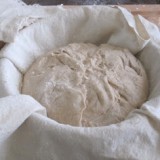
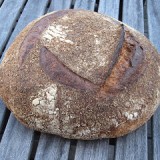
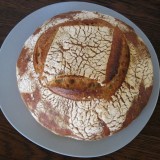
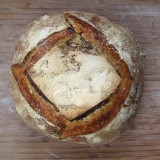
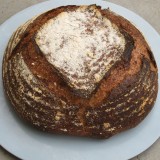
Being half German, I miss Landbrot with a thick, crunchy crust like crazy . I have attempted bread baking with very sad results and was wondering if you could suggest how to start as a newbie.
Please email me tips directly at [email protected] – thanks!
Enzie
Erik, our household anxiously awaits your e-book on whole wheat sourdough with home-milled flour!
We live close to an excellent artisan bakery, and spend ridiculous amounts of $ on bread each week. We’ve baked a lot of bread in our lifetimes, and are willing to do it again. For a few years we relied on a tweaked version of Peter Rinehart’s ciabatta poolish-based loaf. But recently we decided to take the plunge: we bought sacks of whole grains, dug out our old nutri-mill, looked for new recipes online, and got ready to wean ourselves off the bakery. But the results have been…meh. The fresh-milled flour behaves so differently. We used a whey soaker and ended up with a decent-enough sandwich bread, but we’re looking for a real, chewy, artisan, bubbly levain loaf. Help!
We know there are a few forums and cookbooks around, and I’ve been tempted to try the Josey Baker one based on your recommendation, but I’ve been worried that if we’re using fresh milled flour, they won’t really work.
Prior to trying your sourdough recipe in The Urban Homestead, the only bread I had baked was challah. But your sourdough got my husband and me hooked! So I look forward to your follow ups about making whole grain sourdough. I’ve also been going through the recipes in The Bread Bible, and I really like how she lays out the instructions (she also has a section on high altitude baking, which has been quite helpful!)
We recently joined a local food co-op, and one of the farmers does heritage grains, similar to Grist and Toll. For my first order that I pick up today, I’m getting a small bag each of triticale and winter red. Any favorite suggestions for those? I’m looking forward to experimenting!
Correction to my earlier comment: we got Turkey Red, not winter red flour
I’ve made bread with a winter red–no experience yet with triticale. And my bread methods have greatly simplified since The Urban Homestead. Good to hear that it got you baking!
I’ve been playing with whole grain sourdough bread for a while. It took me a lot of experimentation to get a bread with no white flour to rise well on sourdough. Sadly, we don’t have a Grist & Toll in the bay area, but I can buy a local Community Grains hard red winter wheat flour. I’ve got a Country Living Mill for grinding flour by hand, but discovered that part of the problem I was having was that the bran does not come out as fine. I’ve resorted to sifting the flour to remove the bran and regrind it. This has resulted in a much higher loaf. So now most of my loaves are about 60% Hard Red and 30% hand ground, sprouted local emmer, rye, or einkorn. I haven’t been able to locate any locally grown Sonoran white wheat berries yet, which I would like to use for pastries. Let me know if you know of any from the bay area. I like your suggestion of shortening the fermentation time. I think I will try that next time. Thanks for all your research!
Hi Pamina. Indeed–fineness of the flour is important. I just did a comparison of my home mill against some flour from Grist & Toll. It turns out that I’ve been milling my flour too course. Thankfully, I think I can get a finer grind out of the Komo. It’s either that or shift to a style of bread that uses a courser grind. Sifting, like you do, is another option–that’s what the Germans and Austrians do with rye breads, I learned recently.
I have been wrestling with 100% whole wheat, home ground (All-Rite stone mill) sourdough for well over a year now.
Well, I have been on hiatus recently, but keep feeding my starter.
I have made nice, very edible loaves, with very nice crust and photogenic oven spring. But with the next batch of wheat, all was lost, and even adding white flour has not attained previous heights.
And reading this woman’s posts did not help my morale:
Why protein amount in bread flour is irrelevant | azélia’s kitchen
Thanks for sending that article Ruben. Very interesting. I’ve finally settled on a whole wheat that has good gluten properties and performs consistently. That was after many pancake loaves. Milling my own flour has been rewarding, but frustrating too. The fineness of the flour is super important!
Erik, can you talk more about the fineness of the flour? How fine? What about the brans?
I am a little dispirited by all this. I bought a 10kg. sack of wheat of a type and from a supplier that had previsouly made good bread for me. This sack is not so good.
So what do I do with 8 kg. of less awesome wheat, and how do I find wheat that performs better. Is this whole process going to have to be repeated every year when a new crop is sold?
Hey Ruben,
My home milling experiments have been challenging for just this reason. There are so many variables with wheat! Not just type, but weather and soil are factors. It took me quite a few tries to find a variety that works well for bread. That supply will run out soon and the farmer did not grow more this year. I’m lucky to have a friend who runs a mill and is always on the hunt for a good variety (Nan at Grist & Toll). Her plan is to always have a good wheat for bread making on hand.
As to what to do with less than awesome wheat? Pancakes, maybe? Tortillas?
I’ve been making a lot of Bread Without a Timetable. I love the laid-back aspect of the recipe. I tend to only have commercially-milled whole wheat available but I’m hoping the local people will have some flour this summer along with their cornmeal.
http://smittenkitchen.com/blog/2008/09/wheat-bread-without-a-timetable/
I still follow Robertson’s method/amounts (my introduction to sourdough) but have switched to a mixture of home-ground spelt and a local (Lancaster Co. PA) wheat that is lower in protein than western wheat but was used for bread back in the day. (I’m looking forward to reading Ruben’s link because, daggone it, all my eastern ancestors ate bread before prairie wheat made its appearance.) With my spelt/wheat combo I’ve had some nice rises but plenty of sad looking pancakes. Last week I got out the old bread pans, forgot to slash, and had a nice rise but ridiculous eruptions.
Your spelt/Robertson loaf sounds a lot like the bread that my friend Mark Stambler makes. Bet it tastes great despite the eruptions.
I wound up buying sourdough starter about a month ago so I could quickly make injera for friends who’d never had it before.
Somewhere in the process of getting it started, I read some of your comments on how challenging it can be to start up a new sourdough culture on whole wheat flour – I think that was a point where I wanted to start transitioning my starter over to whole wheat. Anyway – I tried a single whole wheat feeding, and observed that the sourdough’s activity went WAY down, so I quickly switched back to white flour and have left my starter on white flour so far.
I would suspect that some of the great activity that you’ve observed has to do with working in an environment that is now microbially rich (thanks to lots of baking and brewing), but perhaps also there are different microbes coming in on the wheat varieties you’re using, compared to the stuff I could get in Texas / can get in Nebraska (I just moved and lack your dedication to hunting out specific wheat varieties).
Altogether, the white flour starter has been an adequate compromise in my book. Prior to that, I’d been using baker’s yeast and adding ~1C of white flour to my bread doughs for extra gluten, but with the sourdough starter I just add the starter and whole wheat flour and call it good enough. A friend gave me a little bag of wheat gluten at one point, which also did the trick, but I don’t see a point in keeping the extra ingredient around if I’ve already got white flour. My purist 100% whole-wheat father wouldn’t be completely satisfied, though.
For what it’s worth, here’s a photo-documentation of my bread-making process. Quite un-fancy, but suits my purposes. 🙂
https://www.flickr.com/photos/90295829@N00/sets/72157650773389881/
Also, let me just say I have really appreciated the chance to follow along with your bread-baking adventures over the past couple of years – I’ve learned a lot!
Hi Rebecca–thanks for sharing. I like that your dog is watching the process.
I keep a small amount of white sourdough starter mainly because white flour is cheap. When I want to make whole wheat bread I just built a small amount of that white starter into a whole wheat starter the night before. I’ve also managed to find a whole wheat that is high in gluten and makes decent bread. I need to blog about this–I’ve learned a lot in the past year milling my own wheat.
I look forward to hearing more about your flour successes! I’m currently reading _The Art of Fermentation_, which is suggesting that I could benefit from a few more sourdough pre-feedings before I prepare bread loaves. I suspect I’ll never be finished with the experimentation. 🙂
I’m new to bread baking- and the sourdough thing sounds exciting but also a bit complicated! A few questions:
1. How much starter do you need to raise enough dough for, say, 1 loaf?
2. Michael Pollan mentioned this method in ‘Cooked’; he would first sift out the bran, and once the dough is ready to go into the oven, he put the bran on top of the dough. Would this hack work without compromising texture?
3. Some people suggest using a razor blade for the slashing, is this what most home-bakers do?
Thanks, Erik, for this enlightening post. Along with this and last week’s conversation I have taken my whole wheat sourdough to the next level–best so far and very satisfying. The loaves of Glenn and Emmer are still cooling :).
Thanks! Looking forward to tasting some of your loaves someday soon . . .
I am enjoying your site so much! I came across it while looking for recipes for 100% fresh ground whole wheat bread. I have a grain mill and have been making bread, muffins, anything I need flour for with fresh flour. I make a simple soft loaf that’s good for sandwich bread but I would love a sour dough recipe and more artisan type loaf recipes. I’m looking for that loaf that is crusty on the outside and soft on the inside. Fresh Whole wheat is so different that I haven’t found recipes that convert very well. I’ve also tried to make biscuits and though they taste pretty good they are always crumbly.
Any advice would be greatly appreciated.
Jenny,
I’m thinking of putting together a publication on what I’ve learned milling my own flour. In a nutshell, there is tremendous variation when you start milling your own. Variety and weather can drastically change the way a wheat will perform as bread, muffins, pancakes, etc. I’ve found that I need to go through trial and error before figuring out how to work with a given grain. Also, the roller milled flour we get at the store is a lot different than stone milled flour that you make at home (or buy). What I’ve been doing is finding a source of grain that I like, doing some trial and error and then I’ll buy a lot of it and use it over and over. I’m lucky to have a mill near me that sells me whole kernels, but you could do this elsewhere. I’ve also figured out that some varieties work best as bread, others in baked goods etc.
Thanks for your reply. I would love it if you put together a publication about your findings! I’ll look forward to it.
Holy Toledo. You guys are so far out of my bread making league! I’ve baked 50/50 white/whole wheat loaves for years using the James Beard recipe. No problem. Then, with all the glutenphobia in my SF bay area county I started researching that ol’devil wheat. Like, how bad is it? Well, for about 99% of the population it is mighty fine, so I decided to go whole-hog into whole wheat bread baking. Onto the internet for the basics, I found an article on Smithsonian.com [!] about cooking with whole wheat and one of the gurus has a little bakery a few miles from my kitchen. . . Ponsford’s Place in San Rafael!! Who knew? I’ve made a few pilgrimages, early morning runs before the lines form, and it’s been enlightening, but not helpful. Incredible bread like I’ve never tasted before, but I’m no smarter. How to bake 2 excellent loaves of whole wheat bread? Yesterday I tried the 100/100 water/Stonebuhr 100% WW flour ratio. One TBL active dry yeast. And the dough grew like the Creeping Unknown. It was flopping all over the place when I tried to give it an initial kneading. Finally I gave up and scraped it into two pans. All this bubbly dough to the top edges, but not a millimeter of rise. It just sat there, exhausted. I put it into the 375 degree oven for 35 minutes and got baked bread with holes and chewy texture. It tastes ‘off’ to me. My husband says it’s great. I feel like a failure.